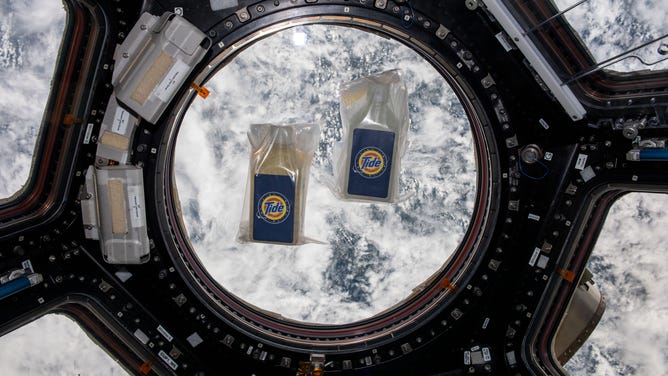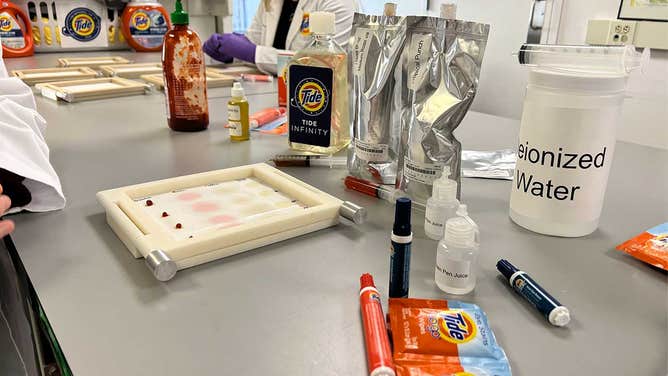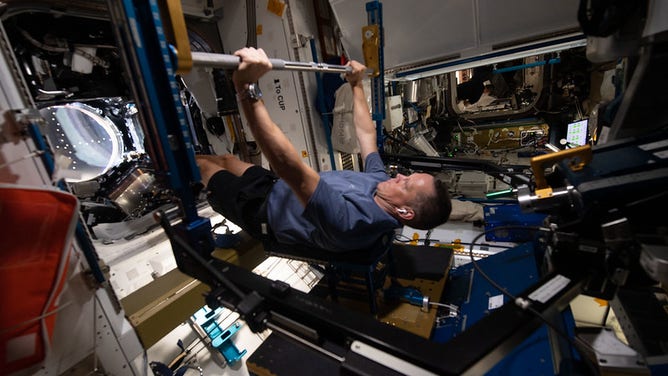Hot sauce stains and reused underwear: Tide helping NASA come up with space laundry solution
Working with reclaimed water in space to do laundry could help scientists learn how to apply those same methods on Earth

Part of the P&G Tide experiment elements pictured floating in the space station cupola.(Image: P&G/NASA)
Astronauts sometimes compare living on the International Space Station to an extended camping trip, but their fellow campers are highly-trained space explorers, all living in close quarters and typically wearing the same clothes for about a week.
There is no orbiting laundromat when you live in space for typically six months, and water is a precious commodity, as are clean clothes. When a NASA astronaut launches from Kennedy Space Center on their long-duration mission, the clothes for their mission also launch, but while the astronauts always come home, their clothes don't.
"There's no washing machine. There's not really an option to wash their clothes. The crew members wear their clothes until they're no longer sanitary," Proctor & Gamble principal scientist for fabric care Jennifer Ahoni said.
HOW TO WATCH FOX WEATHER ON TV
According to NASA, if the agency packed enough underwear for three crew members to have a clean pair every day for six months, that would require launching 540 pairs of underwear into orbit. There isn't storage space on the ISS for all those clothes.
This can mean up to a week in the same clothes. Eventually, astronaut laundry items are thrown away and burned up in Earth's atmosphere.
"You can imagine how gross and smelly and just disgusting that they feel," Ahoni said.
Ahoni explains that the company entered a Space Act Agreement with NASA about a year ago to develop laundry solutions in space.
As a biomedical engineer and the director of P&G's North American Fabric Care Scientific Communication team, Ahoni says most people would be surprised at how much science goes into the everyday products they use at home.

Tide Infinity, Tide pens and stain products part of the P&G experiment that has flown several versions to the International Space Station laboratory. (Image: P&G)
"We know that there are a lot of different constraints back here on Earth as we look at what is happening with our planet, climate change, water scarcity. These are all problems that are really at the front and center right now that we have to address and have to come up with sustainable solutions," Ahoni said.
The science of laundry is now on round two of experiments on the orbiting laboratory.
In December 2021, a prototype detergent known as Tide Infinity was launched to the ISS. Some stain-fighting science, including Tide wipes and pens, launched on a SpaceX Cargo Dragon spacecraft last week.
SpaceX launches 25th cargo mission to ISS for NASA
5,800 pounds of supplies launched on SpaceX's 25th cargo re-supply mission for NASA.
In the coming weeks, two P&G research and development team members will begin working with the astronauts on the ISS via video chat to walk them through the stain removal process.
"We've come up with a set of staining protocols on particular types of fabrics for us to be able to broadly test a wide range of stains," Ahoni said.
SPACEX FALCON 9 LAUNCHES SUPPLIES TO SPACE STATION, INCLUDING NASA CLIMATE SCIENCE TECHNOLOGY
P&G's researchers determined some of the most relevant stains found around the space station on fabrics, which will be the priority of the experiment conducted by the astronauts. One of those stains will be Sriracha hot sauce, a popular food item among the astronauts.
Ahoni explains the research team hopes to learn how stain-flighting ingredients used on Earth work in the microgravity environment.

NASA astronaut and Expedition 67 Flight Engineer Bob Hines works out on the Advanced Resistive Exercise Device (ARED) inside the International Space Station's Tranquility module. (Image: NASA)
"That will really help us understand as we further develop prototypes and tweaks for formulations that can work in space," Ahoni said. "Do our stain-fighting ingredients operate in the same way? So really just understanding how is the performance in space versus how we rate that performance on Earth."
The ongoing laundry experiment in space will also benefit those on Earth as water resources become scarce and natural disasters leave people without ways to do laundry.
One of the constraints of the Tide Infinity prototype was that it worked with the space station's reclaimed water filtration system.
"If we can learn how to produce detergent that is able to work in those water-constrained systems there, we also have the hope of being able to offer those types of detergents to our consumers (on Earth)," Ahoni said.
In the long term, the goal is also to provide a way to do laundry for the astronauts going back to the moon and eventually to Mars.
"So, as we think about specifically each year to the ISS for each crew member, about 160 pounds of clothing are sent. That's a lot of clothing," Ahoni said. "But as we think about what is, we're looking out to the future with space, things like the Artemis Moon mission or the Mars mission, it is not feasible for them to send that amount of clothing that would be needed."
